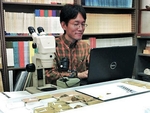Nahoko Tokuyama
Associate Professor, Chuo University (CICASP/WRC Assistant Professor, 2020–2024)
Research
Why do we still want to be with and communicate with someone even when you can live by yourself? I have been having this question since my adolescence, which led me to study social interactions ingroup-living animals. I have been studying wild bonobos at Wamba, Luo Scientific Reserve, DR Congo since 2011. My research focuses on within-group female cooperation and aggregation, as well as social interactions across groups. I also started observing wild chimpanzees at Kalinzu forest, Uganda in 2016.
Keywords
- Ingroup and inter-group social relationships
- Evolution of female-female relationships
- Aggression and conflict management
Selected Publications
Peer reviewed papers
- Ishizuka S, Takemoto H, Sakamaki T, Tokuyama N, Toda K, Hashimoto C, Furuichi T (2020). Comparisons of between-group differentiation in male kinship between bonobos and chimpanzees. Scientific Reports, 10:1-8.
- Tokuyama N, Sakamaki T & Furuichi T (2019). Inter-group aggressive interaction patterns indicate male mate defense and female cooperation across bonobo groups at Wamba, Democratic Republic of the Congo. American Journal of Physical Anthropology.
- Tokuyama N (2019). Snare-related disability led to the near-fatal accident of a bonobo at Wamba, Democratic Republic of the Congo. Pan African News, 26: 7-9.
- Toda K, Tokuyama N, Ishizuka S & Furuichi T (2018). A short-term visit of an adult male bonobo from the neighboring unit-group at wamba. Pan African News, 25(2), 22-24.
- Surbeck M, Boesch C, Crockford C, Thompson ME, Furuichi T, Fruth B, Hohmann G, Ishizuka S, Machanda Z, Muller MN, Pusey A, Sakamaki T, Tokuyama N, Walker K, Wrangham R, Wroblewski E, Zuberbühler K, Vigilant L & Langergraber K (2019). Males with a mother living in their group have higher paternity success in bonobos but not chimpanzees. Current Biology, 29(10): R354-R355.
- Sakamaki T, Ryu H, Toda K, Tokuyama N, Furuichi T (2018). Increased frequency of intergroup encounters in wild bonobos (Pan paniscus) around
the yearly peak in fruit abundance at Wamba. International Journal of Primatology 39(4): 685-704. - Ishizuka S, Kawamoto Y, Sakamaki T, Tokuyama N, Toda K, Okamura H & Furuichi T (2018). Paternity and kin structure among neighbouring groups in wild bonobos at Wamba. Royal Society Open Science 5(1), 171006.
- Toda K, Tokuyama N & Furuichi T (2017). An old female bonobo carried a dead red-Tailed monkey for over a month. Pan Africa News 24 (2), 19-21.
- Takemoto H, Kawamoto Y, Higuchi S, Makinose E, Hart JA, Hart TB, Sakamaki T, Tokuyama N, Reinartz GE, Guislain P, Depain J, Cobden AK, Mulavwa MN, Yangozene K, Darroze S, Devos C & Furuichi T (2017). The mitochondrial ancestor of bonobos and the origin of their major haplogroups. Pros One 12(5), e0174851.
- Tokuyama N & Furuichi T (2017). Leadership of old females in collective departures in wild bonobos (Pan paniscus) at Wamba. Behavioral Ecology and Sociobiology 71, 55.
- Tokuyama N, Moor DL, Graham KE, Lokasola A & Furuichi T (2017). Cases of maternal cannibalism in wild bonobos (Pan paniscus) from two different field sites, Wamba and Kokolopori, Democratic Republic of the Congo. Primates, 58(1), 7-12.
- Yoshida T, Takemoto H, Sakamaki T, Tokuyama N, Hart J, Hart T, Dupain J, Cobden A, Mulavwa M, Kawamoto Y, Kaneko A, Enomoto Y, Sato E, Kooriyama T, Miyabe-Nishiwaki T, Suzuki J, Saito A, Okamoto M, Tomonaga M, Matsuzawa T, Furuichi T & Akari H (2016). Epidemiological surveillance of lymphocryptovirus infection in wild bonobos. Frontiers in microbiology 7, 1262.
- Tokuyama N & Furuichi T (2016). Do friends help each other? Patterns of coalition formation in wild bonobos at Wamba. Animal Behaviour, 119, 27-35.
- Tokuyama N (2015). A case of infant carrying against the mother’s will by an old adult female bonobo at Wamba, Democratic Republic of Congo. Pan Africa News, 22(2), 15-17.
- Toda K, Sakamaki T, Tokuyama N & Furuichi T (2015). Association of a young emigrant female bonobo during an encounter with her natal group. Pan Africa News 22(1), 10-12.
- Furuichi T, Sanz C, Koops K, Sakamaki T, Ryu H, Tokuyama N, Morgan D, & Fisher LE (2015). Why do wild bonobos not use tools like chimpanzees do?. Behaviour 152, 425 – 460.
- Tokuyama N & Furuichi T (2014). Redirected aggression reduces the cost for victims in semi-provisioned free-ranging Japanese macaques (Macaca fuscata fuscata). Behaviour 151, 1121-1141.
- Kawamoto Y, Takemoto H, Higuchi S, Sakamaki T, JA Hart, TB Hart, N Tokuyama, GE Reinartz, P Guislain, J Dupain, AK Cobden, MN Mulavwa, K Yangozene, S Darroze, C Devos & T Furuichi (2013). Genetic structure of wild bonobo populations: diversity of mitochondrial DNA and geographical distribution. PLoS ONE 8, e59660.
- Tokuyama N, Emikey B, Bafike B, Isolumbo B, Iyokango B, Mulavwa MN & Furuichi T (2012). Bonobos apparently search for a lost member injured by a snare. Primates 53 (3), 215-219.
Book chapters
- Yamamoto S, Tokuyama N, Clay Z, Hare B (2019). Chimpanzee and Bonobo. In: Choe, J.C. (Ed.), Encyclopedia of Animal Behavior, (2nd ed.). vol. 1, pp. 324–334. Elsevier, Academic Press.
- Sakamaki T, Behncke I, Laporte M, Mulavwa M, Ryu H, Takemoto H, Tokuyama N, Yamamoto S & Furuichi T (2015). Intergroup transfer of females and social relationships between immigrants and residents in bonobo (Pan paniscus) societies. In Furuichi T, Yamagiwa J & Aureli F (eds.), Dispersing Primates Females, Springer, pp127-169.
Press
- Bonobo Matriarchs Lead the Way", Inside Science, 17th Mar 2017. https://www.insidescience.org/news/bonobo-matriarchs-lead-way
- "'Hippie' apes seen eating their own dead children", BBC Earth, 26th Oct 2016. http://www.bbc.com/earth/story/20161026-hippie-apes-seen-eating-their-own-dead-children
- “In the Bonobo World, Female Camaraderie Prevails”, The New York Times, 10th Sep 2016. https://www.nytimes.com/2016/09/13/science/bonobos-apes-matriarchy.html
- "Bonobos Form All-Female Coalitions to Target Violent Males", The Science Explorer, 20th Jul 2016. http://thescienceexplorer.com/nature/bonobos-form-all-female-coalitions-target-violent-males
- "Female bonobos shut down violent males. Here's what humans can learn from them", Upworthy, 4th Aug 2016. http://www.upworthy.com/female-bonobos-shut-down-violent-males-heres-what-humans-can-learn-from-them
- "Bonobos are caring because they are led by females", New Scientist, 7th Mar 2012. https://www.newscientist.com/article/mg21328553-800-bonobos-are-caring-because-they-are-led-by-females
Contact
Tokuyama [dot] nahoko [dot] 6r [at] kyoto-u [dot] ac [dot] jp



